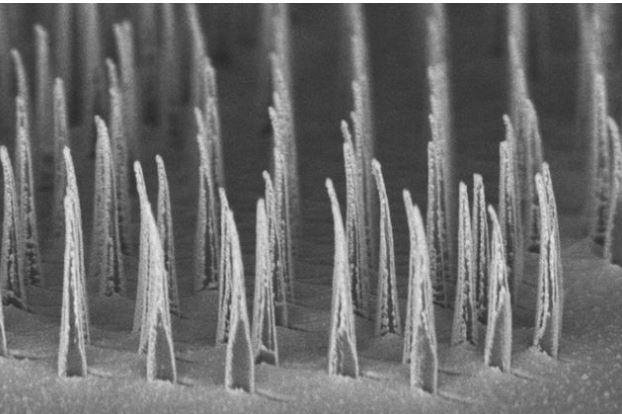This image shows nanospears before being released for delivery of genetic information to cells. Photo courtesy of UCLA Broad Stem Cell Research Center/ACS Nano
March 15 (UPI) -- UCLA scientists have developed new microscopic structures called "nanospears" that could make gene therapies safer, faster and more cost-effective.
The method of creating a targeted delivery of biomolecules, such as genes straight to patient cells, was explained in a paper published Wednesday in the journal ACS Nano.
"Just as we hear about Amazon wanting to deliver packages straight to your house with drones, we're working on a nanoscale equivalent of that to deliver important health care packages straight to your cells," Dr. Steven Jonas, a clinical fellow in the UCLA Broad Stem Cell Research Center Training Program, said in a press release.
Jonas hopes the nanostructures can deploy cell and gene therapies quickly and widely to his pediatric cancer patients, including at the UCLA Mattel Children's Hospital.
Gene therapy, in which missing or defective genes in patient cells are added or replaced, has been effective for treating diseases, including hemophilia, muscular dystrophy, immune deficiencies and certain types of cancer.
In current gene therapy, only modified viruses, external electrical fields or harsh chemicals are used to penetrate cell membranes and deliver genes straight to patient cells. These processes are costly, inefficient or cause undesirable stress and toxicity to cells, the researchers said.
Jonas and Paul Weiss, a distinguished professor of chemistry and biochemistry at UCLA, led a research team that designed nanospears that are biodegradable, and can be mass-produced inexpensively and efficiently.
These nanospears, which are made from silicon, nickel and gold, are about 5,000 times smaller than the diameter of a strand of human hair. Yet they include genetic information with minimal impact on cell viability and metabolism.
The researchers worked with UCLA collaborators, Hsian-Rong Tseng, a professor of molecular and medical pharmacology, and Xiaobin Xu, a postdoctoral fellow in Weiss' interdisciplinary research group.
"Based on Xiaobin's nanomanufacturing work, we knew how to make nanostructures of different shapes in massive numbers using simple fabrication strategies," Weiss said. "Once we had that in hand, we realized we could make precise structures that would be of value in gene therapies."
Other researchers have developed guided nanostructures, or robotic "nanomotors," to enhance gene therapies, but they have limited precision and required potentially toxic chemicals to propel the structures to their targets.
The UCLA researchers used a magnet near a lab dish containing cells to manipulate the direction, position and rotation of one or many nanospears. Weiss and Jonas envision guiding the nanospears remotely within the body to treat genetic diseases.
Immunotherapy, when patient-specific immune cells are genetically engineered to recognize and attack cancer cells, also relies on expensive or lengthy processing methods.
"The biggest barrier right now to getting either a gene therapy or an immunotherapy to patients is the processing time," Jonas said. "New methods to generate these therapies more quickly, effectively and safely are going to accelerate innovation in this research area and bring these therapies to patients sooner, and that's the goal we all have."















